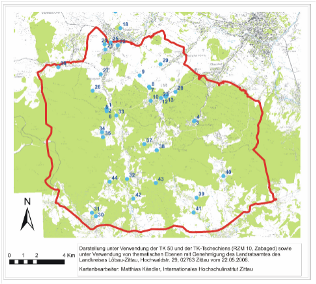Nachhaltiges Bergwiesenmanagement im Zittauer und Lausitzer Gebirge

| Nachhaltiges Bergwiesenmanagement im Zittauer und Lausitzer Gebirge |
Case Study Region | Dresden region (Direktionsbezirk Dresden), Upper Lusatia and Lower Silesia (Oberlausitz-Niederschlesien) |
| The Lausitzer Mountains (Lausitzer Gebirge/Křížová hora) are located at the German-Czech border (nearby the D-PL-CZ border triangle) in the south-eastern part of Saxony (district Görlitz) and North Bohemia in the Czech Republic. Highest peaks of the Lausitzer Mountains are the Lausche (Luž) with 793 meters, the Finkenkoppe (Pěnkavčí vrch) with 792 meters and the Tannenberg (Jedlová) with 774 meters. The German part of the Lausitzer Mountains is called Zittau Mountains (Zittauer Gebirge). |
Type | Advice service; project |
Main activity / focus
| The overall project “Sustainable management of mountain meadows in Zittau Mountains and Lausitzer Mountains” aims at a sustainable way of utilization and preservation of grasslands in mountain areas. To achieve this goal, it is advised to use the produced biomass also for energetic purposes. |
Target beneficiaries / market | Agricultural enterprises (owners of meadows), regional tourism sector, natural environment. |
Year established
| During the period 2006-2008 (first funding period) a sub-project titled Nachhaltiges Bergwiesenmanagement im Zittauer und Lausitzer Gebirge – Konzept einer Machbarkeitsstudie (Sustainable management of mountain meadows in Zittau Mountains and Lausitzer Mountains – concept of a feasibility study) was realized. Currently, in the period 2009-2011 (second funding period) a sub-project titled Potenzialerschließung bislang nicht genutzter nachwachsender Rohstoffe – am Beispiel von Grünflächen in Gebirgslagen im Naturpark Zittauer Gebirge und Lausitzer Gebirge (Development of unexploited potentials of renewable resources: the example of grasslands in mountainous areas of the nature park Zittau Mountains and Lausitzer Mountains) is implemented. |
Current Funding source(s) | Both parts of the project (feasibility study and project implementation) were funded by the Deutsche Bundesstiftung Umwelt(DBU) (German Environment Foundation). |
| Project partners in the period 2009-2011 are:
|
Website | http://www.netsci.de; http://www.dbu.de/ab/DBU-Abschlussbericht-AZ-22941.pdf |
Description
| Grasslands and meadows are not only important as animal feed, but also as open country for habitat protection. Besides, grasslands contribute to a high diversity of the landscape, and thus to high attractiveness regarding tourism – even in the Lausitzer and Zittau Mountains. Against this background, the preservation of grassland areas is an important matter that should be supported. In order to meet the aims of nature protection and the EU Water Framework Directive the management of grasslands should be based on principles of extensive land use, respectively with limitations regarding the utilization of pesticides. The political and economic development of the past century contributed to the abandonment of meadows in the Lausitzer Mountains. Today’s challenge is to preserve the traditional meadow landscapes by regular and extensive forms of utilization. However, this has to be done in a profitable way. The structural change in the Saxon agricultural sector is distinguished by increasing numbers of live stock and rising milk yields at the same time. Consequently, this development leads to an increasing area of unused grassland and surplus of available biomass. Feasibility study:In order to protect valuable meadows in upland areas, the district Löbau-Zittau (today: part of the district Görlitz) developed an international (involving German and Czech areas) and interdisciplinary calculation and simulation model. This instrument offers the possibility to make site-related decisions concerning utilization and logistic measures for land owners and/or users to achieve most profitable results. Furthermore, it enables the preservation of mountain meadows considering protected and protectable species. |
Contact details
| Project executing organization: |